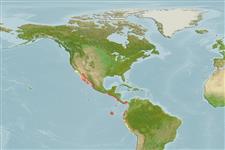Elasmobranchi (squali e razze) (sharks and rays) >
Carcharhiniformes (Ground sharks) >
Carcharhinidae (Requiem sharks)
Etymology: Rhizoprionodon: rhiza (Gr.), root; prion (Gr.) saw; odon (Gr.), tooth, referring to teeth with serrated (saw-like) bases, or roots [replacement name for Rhizoprion Ogilby 1915, preoccupied by Rhizoprion Jourdan 1861 in mammals]. (See ETYFish); longurio: Latin for a tall person, or a “slender youth or stripling” per Jordan & Evermann (1896), allusion not explained, perhaps referring to small, slim body of holotype (a male, presumably mature at 76.2 cm long), much smaller than its presumed congeners in Carcharias (original genus). (See ETYFish).
More on authors: Jordan & Gilbert.
Environment: milieu / climate zone / depth range / distribution range
Ecologia
marino benthopelagico; distribuzione batimetrica ? - 100 m (Ref. 96339). Subtropical; 35°N - 17°S, 121°W - 73°W
Eastern Pacific: southern California, USA to Peru.
Length at first maturity / Size / Peso / Age
Maturity: Lm 63.5, range 58 - 69 cm
Max length : 110 cm TL maschio/sesso non determinato; (Ref. 244); 154.0 cm TL (female)
Adults are found on the continental shelves, more commonly on the littoral zone. Possibly to 154 cm. Viviparous (Ref. 50449). Size at birth 33 to 34 cm. Utilized fresh or frozen for human consumption and also for fishmeal.
Life cycle and mating behavior
Maturities | Riproduzione | Spawnings | Egg(s) | Fecundities | Larve
Distinct pairing with embrace (Ref. 205). Viviparous, placental (Ref. 50449).
Compagno, L.J.V., 1984. FAO Species Catalogue. Vol. 4. Sharks of the world. An annotated and illustrated catalogue of shark species known to date. Part 2 - Carcharhiniformes. FAO Fish. Synop. 125(4/2):251-655. Rome: FAO. (Ref. 244)
IUCN Red List Status (Ref. 130435)
Threat to humans
Harmless
Human uses
Pesca: commerciale
Strumenti
Special reports
Download XML
Fonti Internet
Estimates based on models
Preferred temperature (Ref.
123201): 18.1 - 28.7, mean 24.6 °C (based on 106 cells).
Phylogenetic diversity index (Ref.
82804): PD
50 = 0.5078 [Uniqueness, from 0.5 = low to 2.0 = high].
Bayesian length-weight: a=0.00427 (0.00199 - 0.00915), b=3.11 (2.94 - 3.28), in cm total length, based on LWR estimates for this Genus-body shape (Ref.
93245).
Trophic level (Ref.
69278): 4.2 ±0.7 se; based on diet studies.
Resilienza (Ref.
120179): Basso, tempo minimo di raddoppiamento della popolazione 4.5 - 14 anni (Fec assumed to be <100).
Fishing Vulnerability (Ref.
59153): Very high vulnerability (90 of 100).
Nutrients (Ref.
124155): Calcium = 14.1 [1.9, 80.3] mg/100g; Iron = 0.633 [0.168, 1.855] mg/100g; Protein = 21.5 [18.6, 23.7] %; Omega3 = 0.276 [0.118, 0.584] g/100g; Selenium = 20.7 [6.3, 61.3] μg/100g; VitaminA = 18.8 [6.6, 54.8] μg/100g; Zinc = 0.484 [0.228, 0.887] mg/100g (wet weight);
